1990 VOLKSWAGEN TRANSPORTER ECO mode
[x] Cancel search: ECO modePage 3 of 165
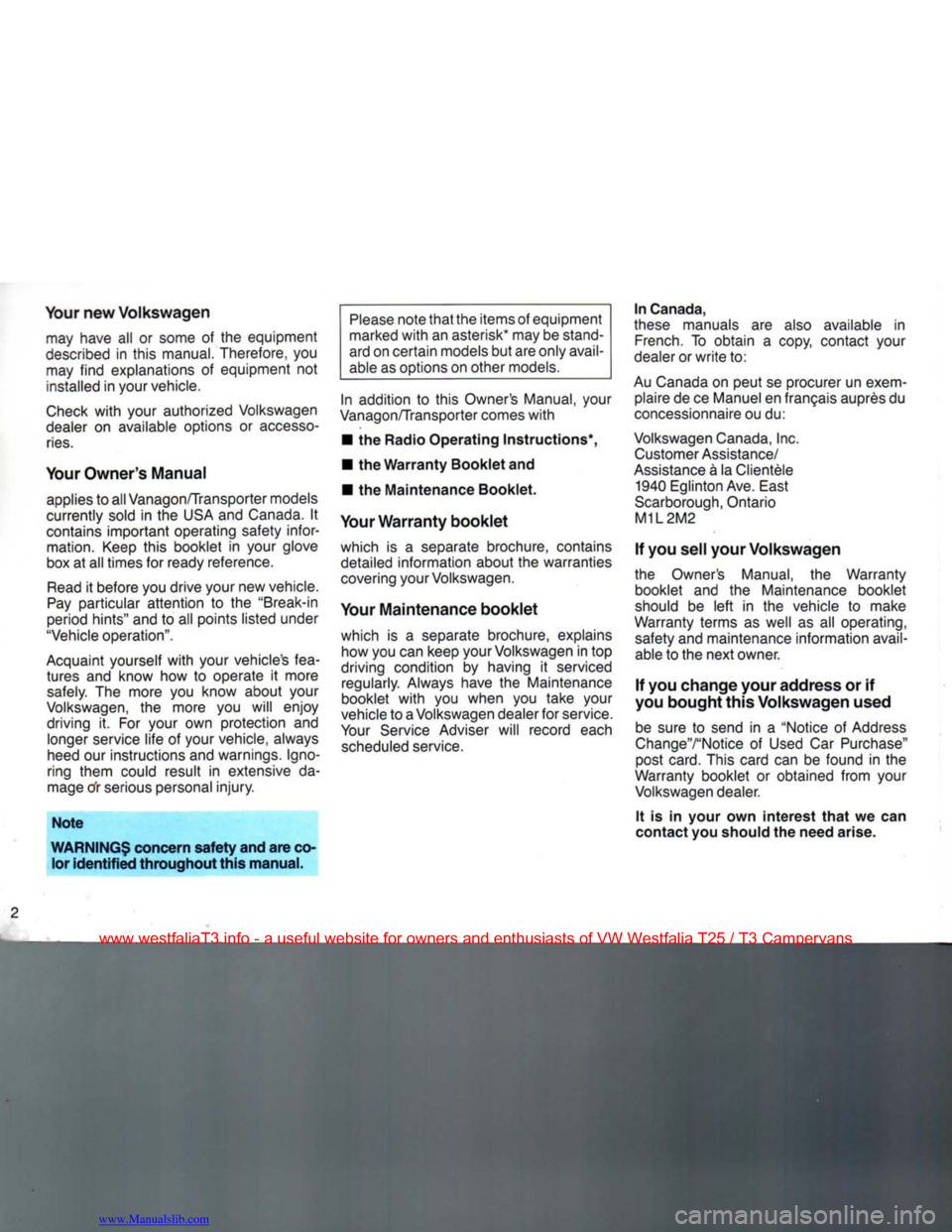
Downloaded from www.Manualslib.com manuals search engine
Your new
Volkswagen
may have all or some of the equipment
described
in this manual. Therefore, you may find explanations of equipment not
installed in your vehicle.
Check
with
your authorized Volkswagen
dealer
on available options or
accesso
ries.
Note
WARNINGS
concern
safety
and are co lor
identified
throughout
this
manual.
Please
note
that
the items of equipment
marked
with
an asterisk* may be stand
ard on certain models but are only avail
able
as options on other models.
In addition to this Owner's Manual, your
Vanagon/Transporter
comes
with
• the Radio
Operating
Instructions*,
In Canada,
these
manuals are also available in
French.
To obtain a copy, contact your
dealer
or
write
to:
Au
Canada
on peut se procurer un exem- plaire de ce Manuel en francais aupres du
concessionnaire
ou du:
Volkswagen
Canada,
Inc.
Customer
Assistance/
Assistance
a la Clientele 1940 Eglinton Ave. East
Scarborough,
Ontario
M1L2M2
If you sell your
Volkswagen
the Owner's Manual, the Warranty booklet and the Maintenance booklet
should
be
left
in the vehicle to make
Warranty terms as well as all operating, safety and maintenance information avail
able
to the next owner.
If you change your address or if
you
bought
this
Volkswagen
used
be
sure to send in a "Notice of Address
ChangeVNotice
of Used Car Purchase"
post card. This card can be found in the
Warranty booklet or obtained from your
Volkswagen
dealer.
It is in your own
interest
that
we can
contact
you should the
need
arise.
Your
Owner's
Manual
applies
to all Vanagon/Transporter models
currently sold in the USA and
Canada.
It
contains important operating safety infor mation. Keep this booklet in your glove
box at all times for ready reference.
Read
it before you drive your new vehicle.
Pay
particular attention to the "Break-in
period hints" and to all points listed under
"Vehicle
operation".
Acquaint
yourself
with
your vehicle's fea tures and know how to operate it more
safely.
The more you know about your
Volkswagen,
the more you will enjoy driving it. For your own protection and longer service life of your vehicle, always
heed
our instructions and warnings. Igno
ring them could result in extensive da
mage
or serious personal injury. • the
Warranty
Booklet
and
• the
Maintenance
Booklet.
Your
Warranty
booklet
which is a separate brochure, contains
detailed information about the warranties
covering your Volkswagen.
Your
Maintenance
booklet
which is a separate brochure, explains how you can keep your Volkswagen in top
driving condition by having it serviced regularly. Always have the Maintenance
booklet
with
you when you take your
vehicle
to a Volkswagen dealer for service.
Your
Service Adviser will record each
scheduled
service.
www.westfaliaT3.info - a useful website for owners and enthusiasts of VW Westfalia T25 / T3 Campervans
Page 6 of 165
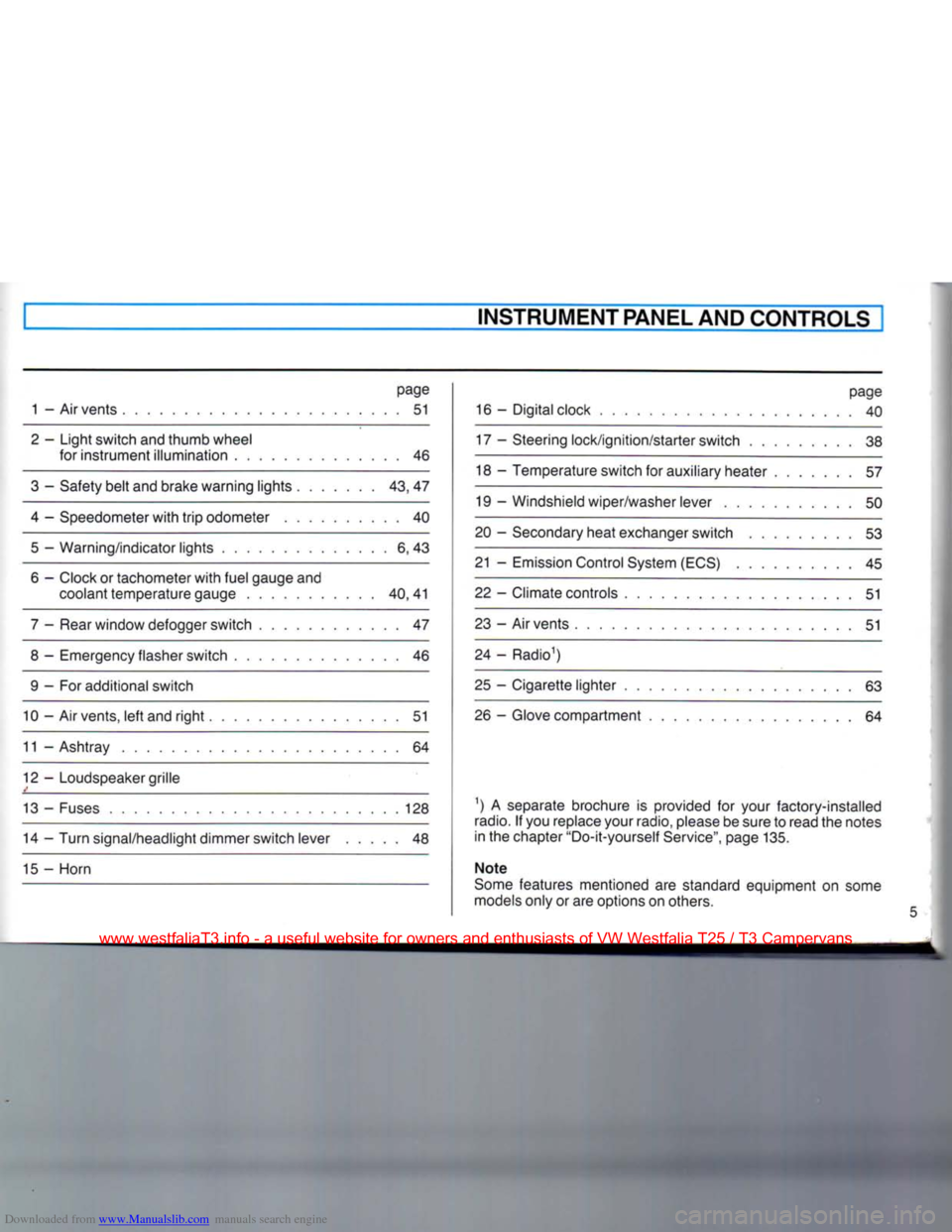
Downloaded from www.Manualslib.com manuals search engine
INSTRUMENT PANEL AND CONTROLS
page
1 - Air vents 51
2 - Light switch and thumb wheel for instrument illumination 46
3 - Safety belt and brake warning lights 43, 47
4 - Speedometer with trip odometer 40 5 — Warning/indicator lights 6, 43
6 - Clock or tachometer with fuel gauge and coolant temperature gauge 40,41
7 - Rear window defogger switch 47
8 - Emergency flasher switch 46 9 - For additional switch
10 - Air vents, left and right 51
11 - Ashtray 64
12 - Loudspeaker grille
13 - Fuses 128 14 - Turn signal/headlight dimmer switch lever 48
15 - Horn page
16 - Digital clock 40
17 - Steering lock/ignition/starter switch 38
18 - Temperature switch for auxiliary heater 57
19 - Windshield wiper/washer lever 50
20 - Secondary heat exchanger switch 53
21 - Emission Control System (ECS) 45
22 - Climate controls 51
23 - Air vents 51
24 - Radio1)
25 - Cigarette lighter 63 26 - Glove compartment 64
1) A separate brochure is provided for your factory-installed
radio.
If you replace your radio, please be sure to read the notes
in the chapter "Do-it-yourself Service", page 135.
Note
Some features mentioned are standard equipment on some
models only or are options on others.
www.westfaliaT3.info - a useful website for owners and enthusiasts of VW Westfalia T25 / T3 Campervans
Page 8 of 165
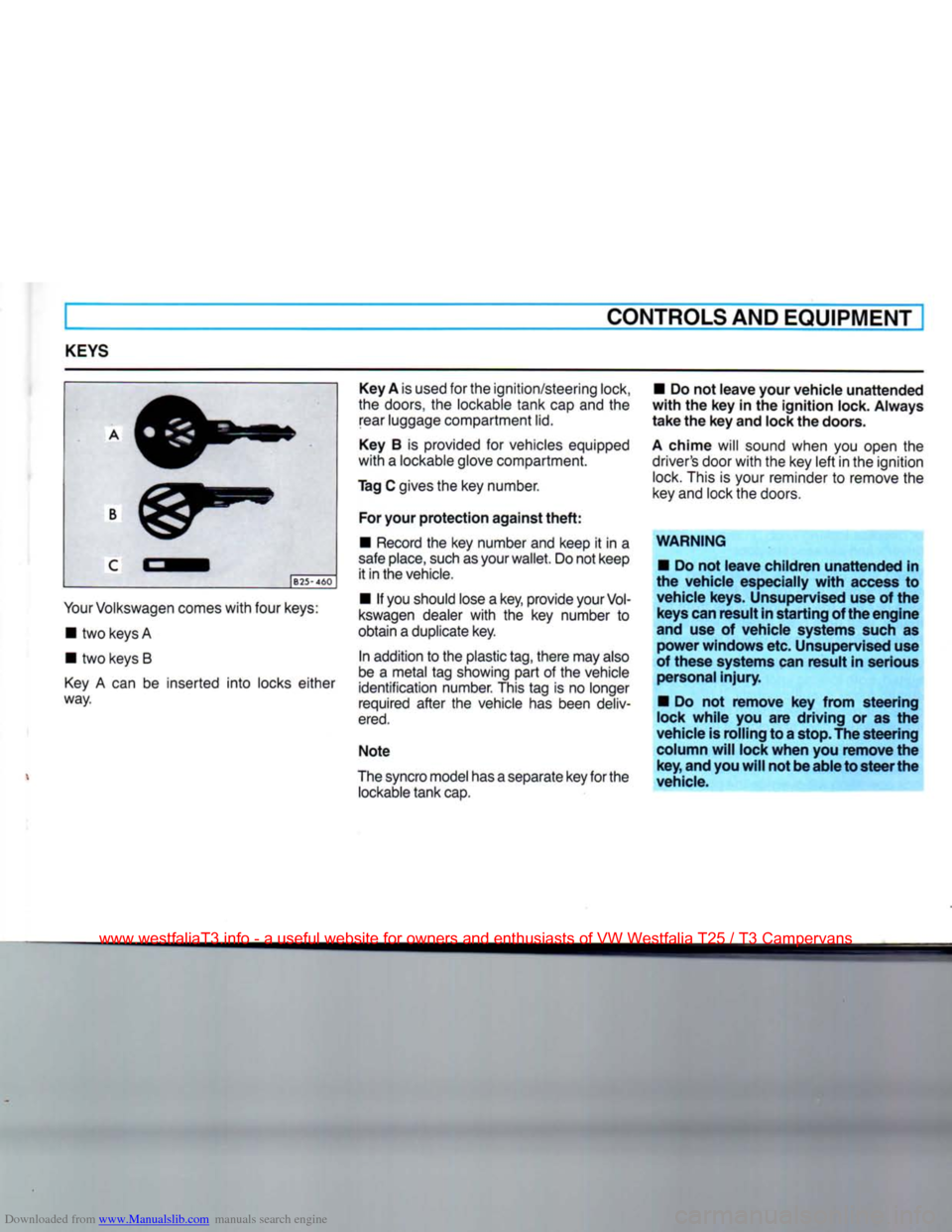
Downloaded from www.Manualslib.com manuals search engine
CONTROLS AND
EQUIPMENT
Key A is used for the ignition/steering lock, • Do not
leave
your
vehicle
unattended
the doors, the lockable tank cap and the
with
the key in the
ignition
lock.
Always
rear luggage compartment lid.
take
the key and lock the doors.
KEYS
B25-460
Your
Volkswagen comes
with
four keys: • two keys A
• two keys B
Key
A can be inserted
into
locks either
way. Key B is provided for vehicles equipped
with
a lockable glove compartment.
Tag C gives the key number.
For
your
protection
against
theft:
• Record the key number and keep it in a
safe
place, such as your wallet. Do not keep it in the vehicle.
• If you should lose a key, provide your
Vol
kswagen dealer
with
the key number to
obtain a duplicate key.
In addition to the plastic tag, there may also
be a metal tag snowing part of the vehicle
identification number. This tag is no longer
required after the vehicle has been deliv
ered.
Note
The syncro model has a separate key for the lockable tank cap.
A
chime
will sound when you open the
driver's door
with
the key
left
in the ignition lock. This is your reminder to remove the
key and lock the doors.
WARNING
• Do not
leave
children
unattended
in
the
vehicle
especially
with
access to
vehicle
keys. Unsupervised use of the
keys
can
result
in
starting
of the
engine
and use of
vehicle
systems such as
power
windows
etc. Unsupervised use
of
these
systems can
result
in serious
personal
injury.
• Do not
remove
key
from
steering
lock
while
you are
driving
or as the
vehicle
is
rolling
to a stop. The
steering
column
will
lock
when
you
remove
the key, and you
will
not be
able
to
steer
the
vehicle.
www.westfaliaT3.info - a useful website for owners and enthusiasts of VW Westfalia T25 / T3 Campervans
Page 33 of 165
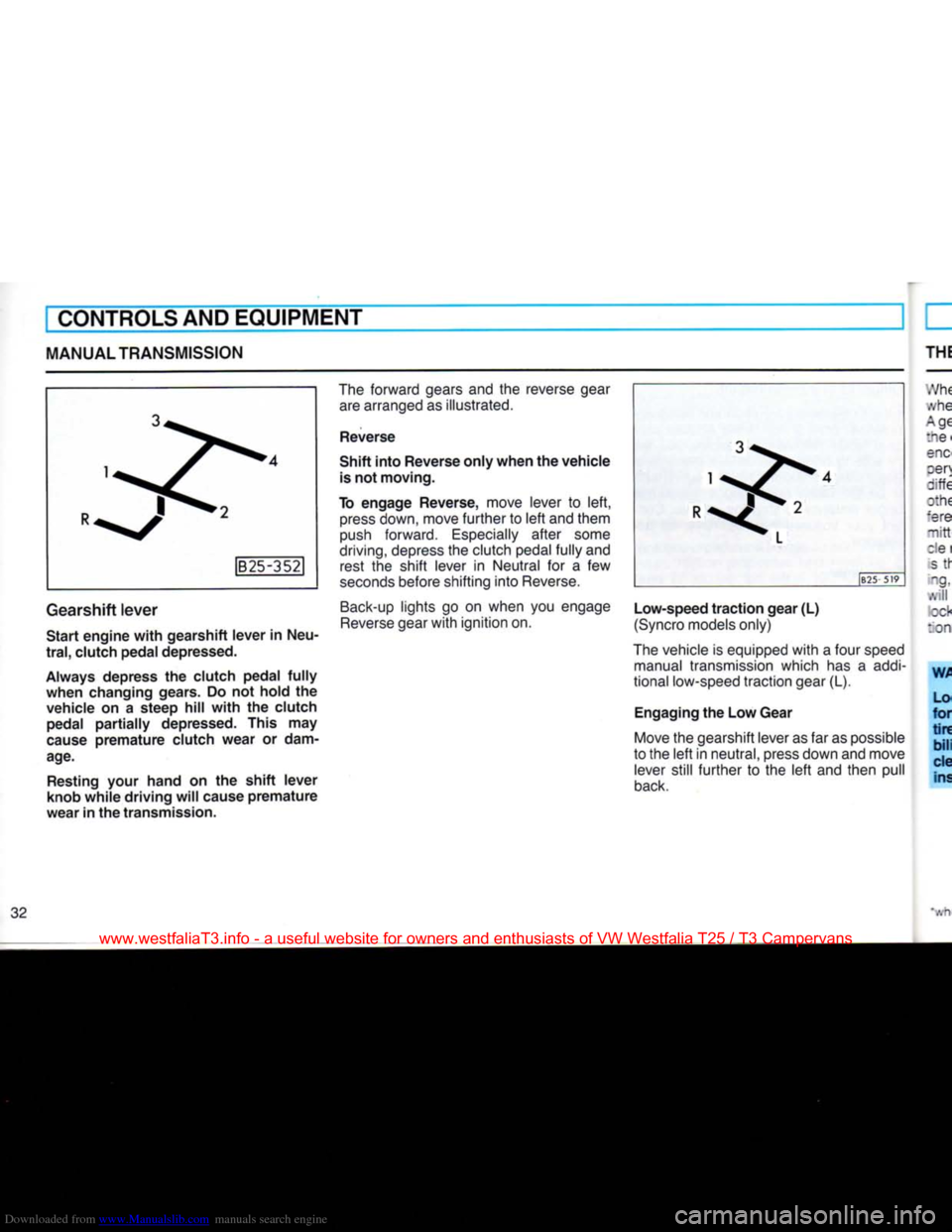
Downloaded from www.Manualslib.com manuals search engine
CONTROLS AND EQUIPMENT
MANUAL TRANSMISSION
B25-352
Gearshift lever
Start engine with gearshift lever in Neu
tral,
clutch pedal depressed.
Always depress the clutch pedal fully
when changing gears. Do not hold the vehicle on a steep hill with the clutch pedal partially depressed. This may
cause premature clutch wear or dam
age.
Resting your hand on the shift lever
knob while driving will cause premature
wear in the transmission. The forward gears and the reverse gear
are arranged as illustrated.
Reverse
Shift into Reverse only when the vehicle is not moving.
To engage Reverse, move lever to left, press down, move further to left and them
push forward. Especially after some
driving,
depress the clutch pedal fully and rest the shift lever in Neutral for a few
seconds before shifting into Reverse.
Back-up lights go on when you engage Reverse gear with ignition on. JB25-519
Low-speed traction gear (L)
(Syncro models only)
The vehicle is equipped with a four speed manual transmission which has a
addi
tional low-speed traction gear (L).
Engaging the Low Gear
Move the gearshift lever as far as possible
to the left in neutral, press down and move lever still further to the left and then pull
back.
www.westfaliaT3.info - a useful website for owners and enthusiasts of VW Westfalia T25 / T3 Campervans
Page 36 of 165
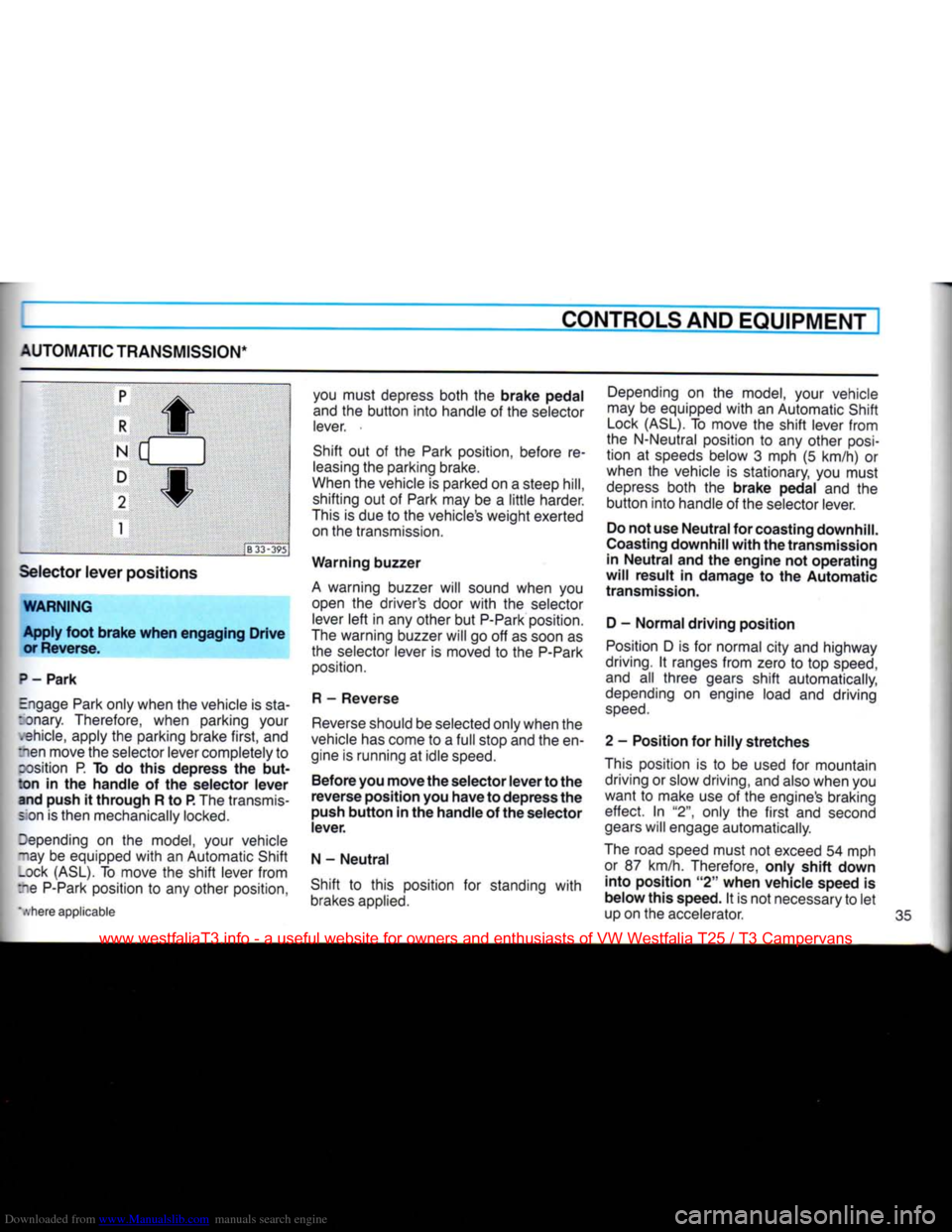
Downloaded from www.Manualslib.com manuals search engine
CONTROLS AND EQUIPMENT
AUTOMATIC TRANSMISSION*
p R
f
N d
D
2
f
1 :'B33-395
Selector lever positions
WARNING Apply foot brake when engaging Drive or Reverse.
P - Park
Engage Park only when the vehicle is
sta
nnary. Therefore, when parking your .snide, apply the parking brake first, and
:nen move the selector lever completely to cosition P. To do this depress the but
ton in the handle of the selector lever and push it through R to P. The transmis-s on is then mechanically locked.
Depending on the model, your vehicle
~iay be equipped with an Automatic Shift _ock (ASL). To move the shift lever from
re
P-Park
position to any other position,
".vhere applicable you must depress both the brake pedal
and the button into handle of the selector lever.
Shift out of the Park position, before re leasing the parking brake.
When the vehicle is parked on a steep
hill,
shifting out of Park may be a little harder.
This is due to the vehicle's weight exerted on the transmission.
Warning buzzer
A warning buzzer will sound when you open the driver's door with the selector lever left in any other but
P-Park
position.
The warning buzzer will go off as soon as the selector lever is moved to the
P-Park
position.
R - Reverse
Reverse should be selected only when the
vehicle has come to a full stop and the en
gine is running at idle speed.
Before you move the selector lever to the
reverse position you have to depress the
push button in the handle of the selector
lever.
N - Neutral
Shift to this position for standing with
brakes applied. Depending on the model, your vehicle
may be equipped with an Automatic Shift
Lock (ASL). To move the shift lever from
the N-Neutral position to any other
posi
tion at speeds below 3 mph (5 km/h) or when the vehicle is stationary, you must
depress both the brake pedal and the button into handle of the selector lever.
Do not use Neutral for coasting downhill.
Coasting downhill with the transmission in Neutral and the engine not operating
will result in damage to the Automatic
transmission.
D - Normal driving position
Position D is for normal city and highway
driving.
It ranges from zero to top speed, and all three gears shift automatically,
depending on engine load and driving
speed.
2 - Position for hilly stretches
This position is to be used for mountain driving or slow driving, and also when you
want to make use of the engine's braking effect. In "2", only the first and second
gears will engage automatically.
The road speed must not exceed 54 mph or 87 km/h. Therefore, only shift down into position "2" when vehicle speed is
below this speed. It is not necessary to let
up on the accelerator. 35
www.westfaliaT3.info - a useful website for owners and enthusiasts of VW Westfalia T25 / T3 Campervans
Page 40 of 165
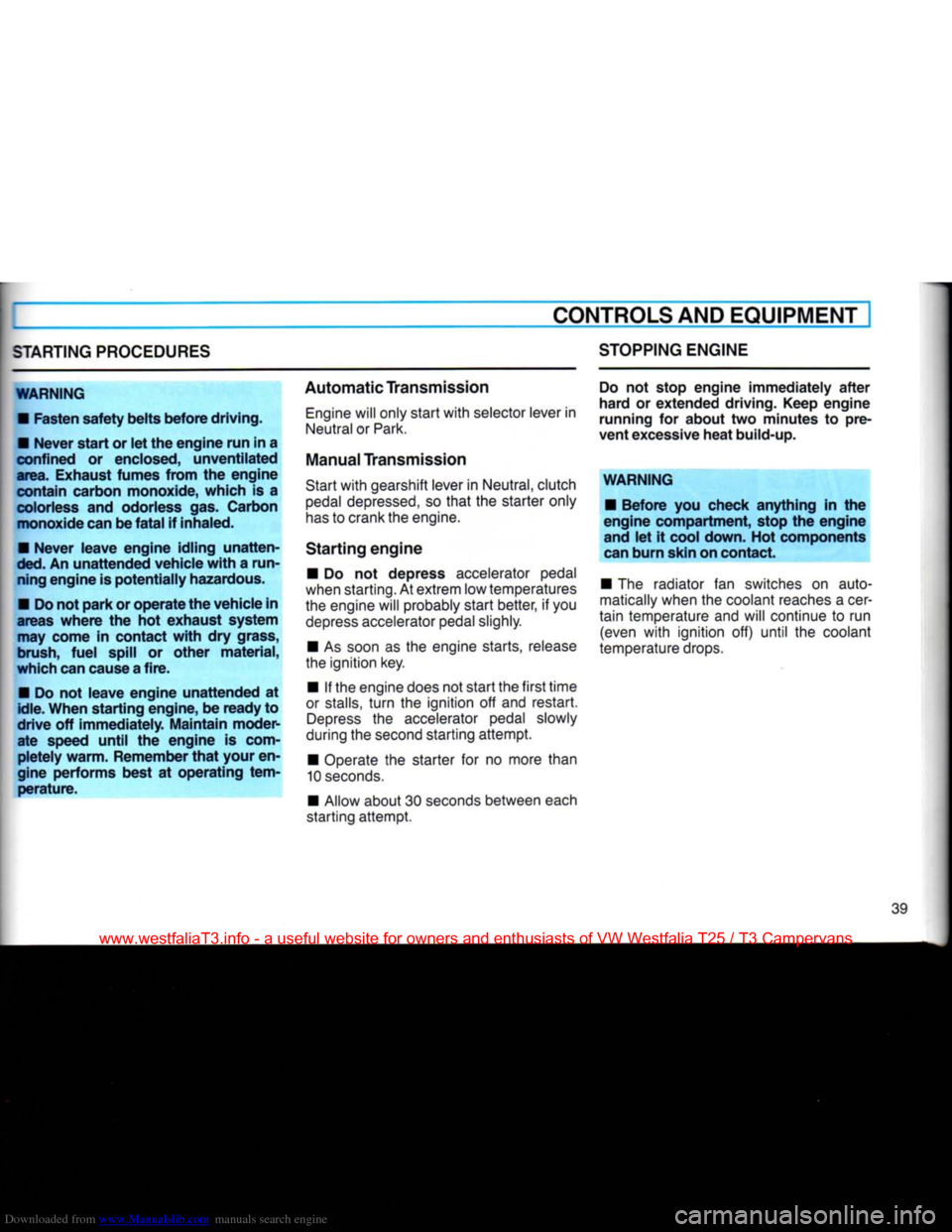
Downloaded from www.Manualslib.com manuals search engine
CONTROLS
AND
EQUIPMENT
STARTING
PROCEDURES
WARNING
•
Fasten safety belts before driving.
•
Never
start or let the engine run in a
confined or enclosed, unventilated
area.
Exhaust fumes from the engine
contain carbon monoxide, which is a
colorless
and odorless gas. Carbon monoxide can be
fatal
if inhaled.
•
Never
leave engine idling unatten
ded.
An unattended vehicle with a run
ning
engine is potentially hazardous.
•
Do not park or operate the vehicle in
areas
where the hot exhaust system may come in contact with dry grass,
brush,
fuel
spill
or other
material,
which can cause a fire.
•
Do not leave engine unattended at
idle.
When starting engine, be ready to
drive off immediately. Maintain moder
ate
speed until the engine is
com
pletely warm. Remember that
your
en
gine performs best at operating
tem
perature.
Automatic
Transmission
Engine will only start with selector lever in
Neutral or Park.
Manual
Transmission
Start with gearshift lever in Neutral, clutch
pedal
depressed, so that the starter only
has
to crank the engine.
Starting
engine
•
Do not depress accelerator pedal
when starting. At extrem low temperatures
the engine will probably start better, if you depress accelerator pedal slighly.
•
As soon as the engine starts, release
the ignition key.
•
If the engine does not start the first time
or
stalls,
turn
the ignition off and restart. Depress the accelerator pedal slowly
during the second starting attempt.
•
Operate the starter for no more than
10
seconds.
•
Allow about 30 seconds between each
starting
attempt.
STOPPING
ENGINE
Do not stop engine immediately after
hard or extended driving. Keep engine
running for about two minutes to pre
vent
excessive heat build-up.
WARNING
•
Before you check anything in the
engine compartment, stop the engine and let it cool down. Hot components
can
burn skin on contact.
•
The radiator fan switches on auto
matically
when the coolant reaches a cer
tain
temperature and will continue to run
(even
with ignition off) until the coolant
temperature drops.
39
www.westfaliaT3.info - a useful website for owners and enthusiasts of VW Westfalia T25 / T3 Campervans
Page 41 of 165
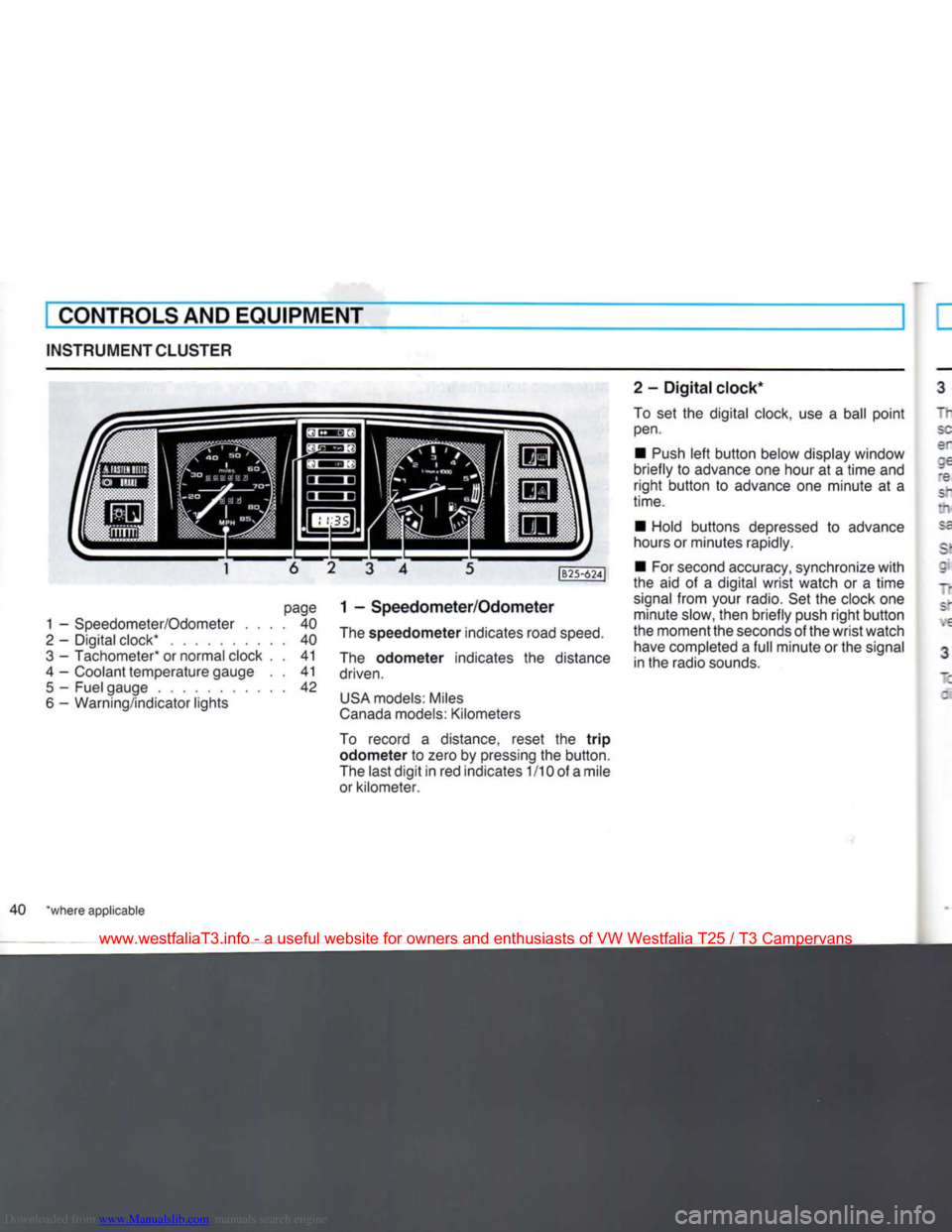
Downloaded from www.Manualslib.com manuals search engine
CONTROLS
AND
EQUIPMENT
INSTRUMENTCLUSTER
page
1 -
Speedometer/Odometer
.... 40
2
-
Digital clock*
40
3
-
Tachometer* or normal clock
. . 41
4
-
Coolant temperature gauge
. . 41
5
-
Fuel gauge
42
6
-
Warning/indicator lights
|B25-624J
1 -
Speedometer/Odometer
The
speedometer
indicates road
speed.
The
odometer
indicates
the
distance
driven.
USA
models: Miles
Canada
models: Kilometers
To record
a
distance, reset
the
trip
odometer to
zero by pressing the button.
The last
digit
in red indicates
1
/10 of a mile
or kilometer. 2
-
Digital
clock*
To
set the
digital clock, use
a
ball
point
pen.
•
Push
left
button
below display window
briefly
to
advance one hour
at a
time
and
right
button
to
advance
one
minute
at a
time.
•
Hold buttons depressed
to
advance
hours or minutes rapidly.
•
For second accuracy, synchronize
with
the
aid of a
digital
wrist
watch
or a
time
signal
from
your radio. Set the clock one minute slow, then briefly push
right
button
the moment the seconds of the
wrist
watch have completed a
full
minute or the signal
in the radio sounds.
40 *where applicable
www.westfaliaT3.info - a useful website for owners and enthusiasts of VW Westfalia T25 / T3 Campervans
Page 90 of 165
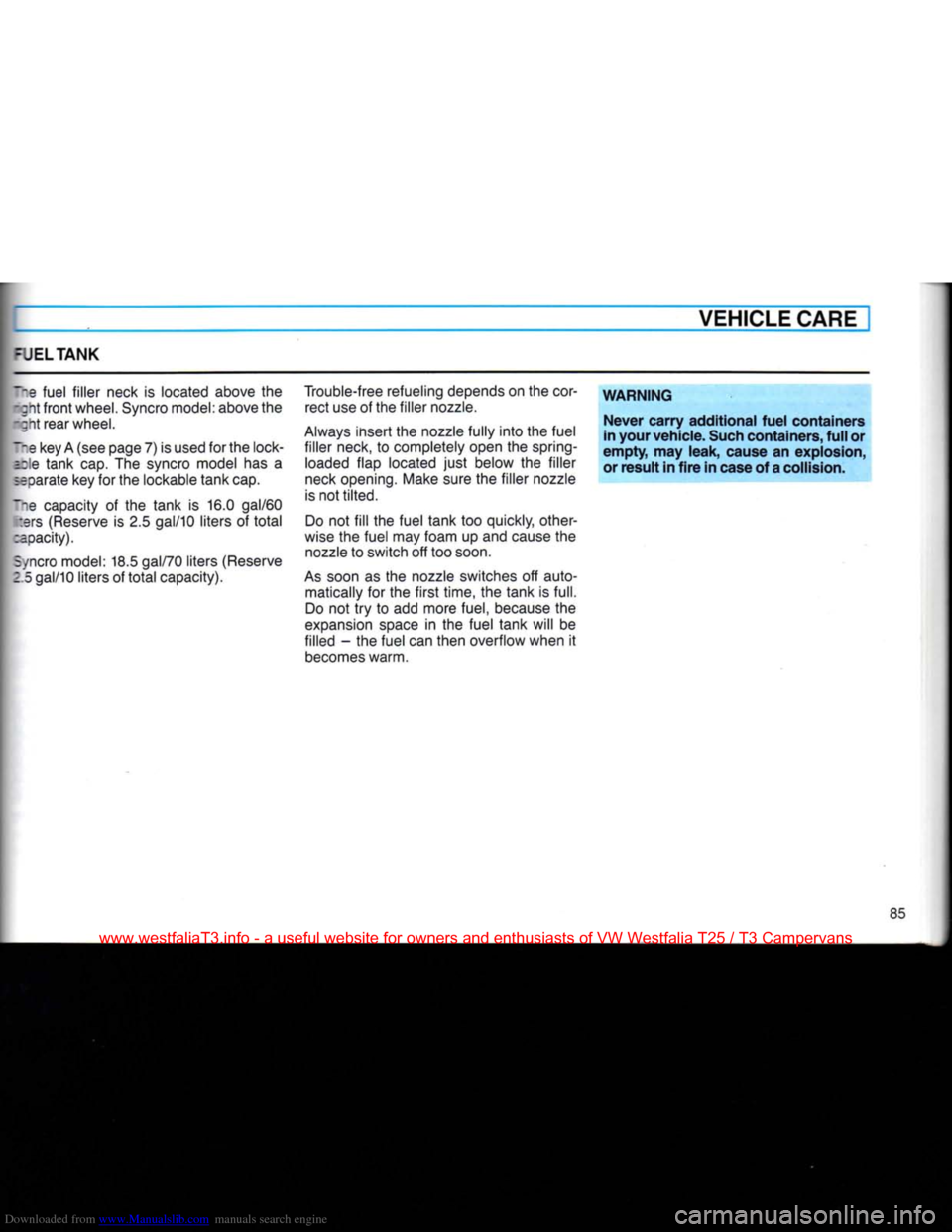
Downloaded from www.Manualslib.com manuals search engine
VEHICLE CARE
=UELTANK
|he fuel filler neck is located above the -gnt
front
wheel. Syncro model: above the
-;nt rear wheel.
mm key A (see page 7) is used for the lock-
acle
tank cap. The syncro model has a separate key for the lockable tank cap.
capacity of the tank is 16.0 gal/60
:ers
(Reserve is 2.5 gal/10 liters of
total
rapacity).
5/ncro model: 18.5 gal/70 liters (Reserve
2
5 gal/10 liters of
total
capacity). Trouble-free refueling depends on the cor
rect use of the filler nozzle.
Always
insert the nozzle fully
into
the fuel filler neck, to completely open the spring-loaded flap located
just
below the filler
neck opening. Make sure the filler nozzle
is
not tilted.
Do
not
fill
the fuel tank too quickly, other
wise the fuel may foam up and cause the
nozzle
to switch off too
soon.
As
soon as the nozzle switches off auto matically for the
first
time, the tank is full.
Do
not try to add more fuel, because the
expansion
space in the fuel tank will be
filled - the fuel can then overflow when it
becomes
warm.
WARNING
Never
carry
additional
fuel
containers
in
your
vehicle.
Such
containers,
full
or
empty,
may
leak,
cause an explosion,
or
result
in
fire
in case of a collision.
85
www.westfaliaT3.info - a useful website for owners and enthusiasts of VW Westfalia T25 / T3 Campervans